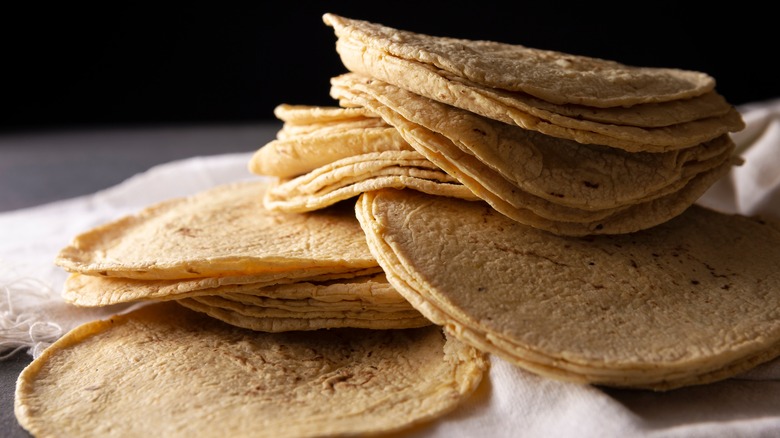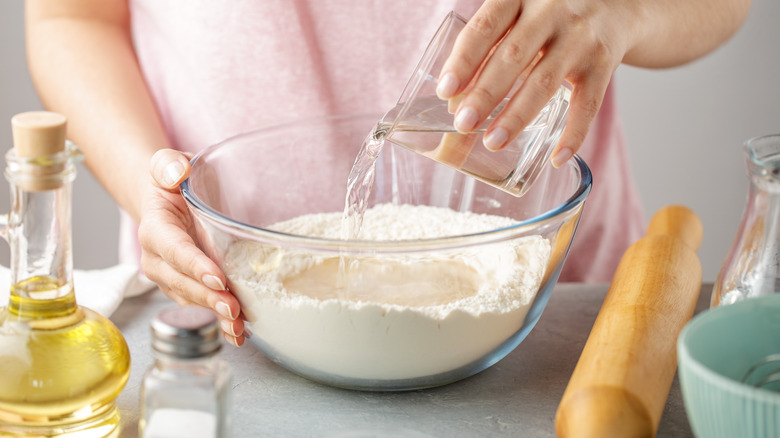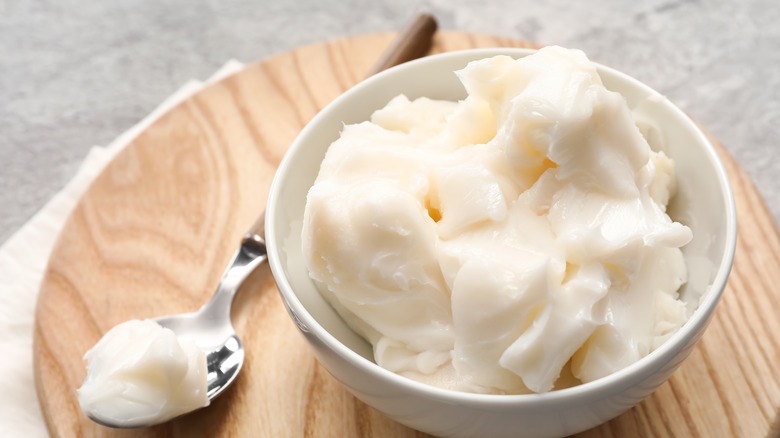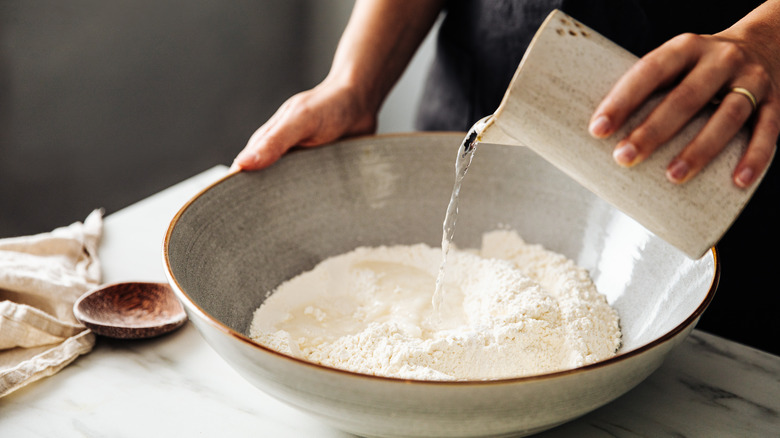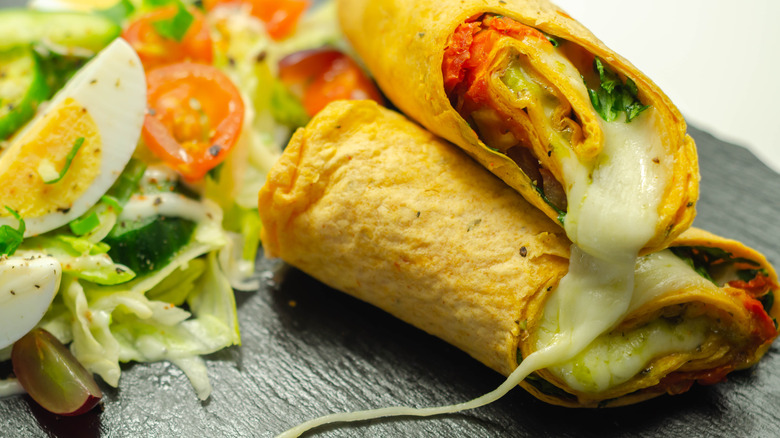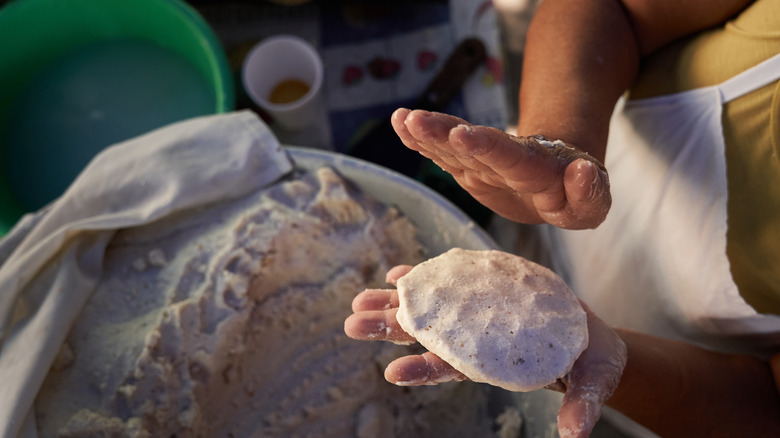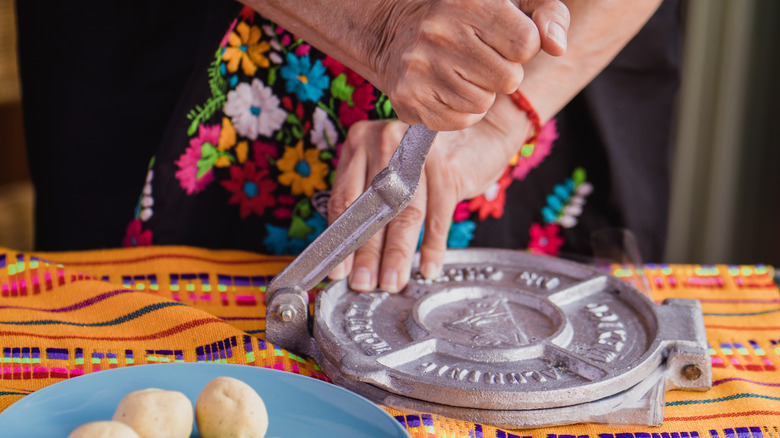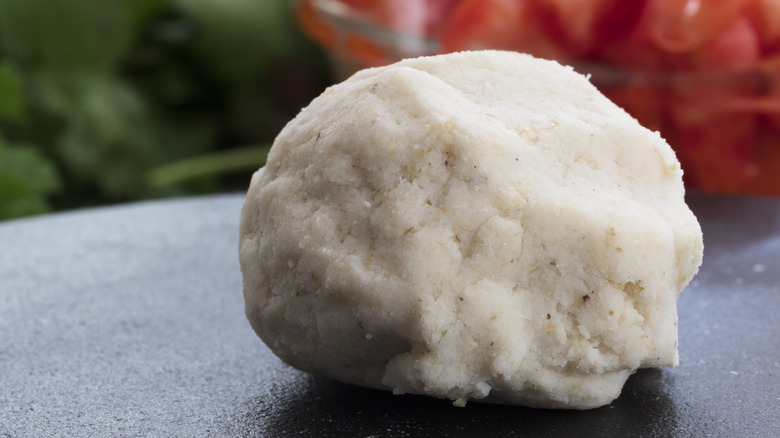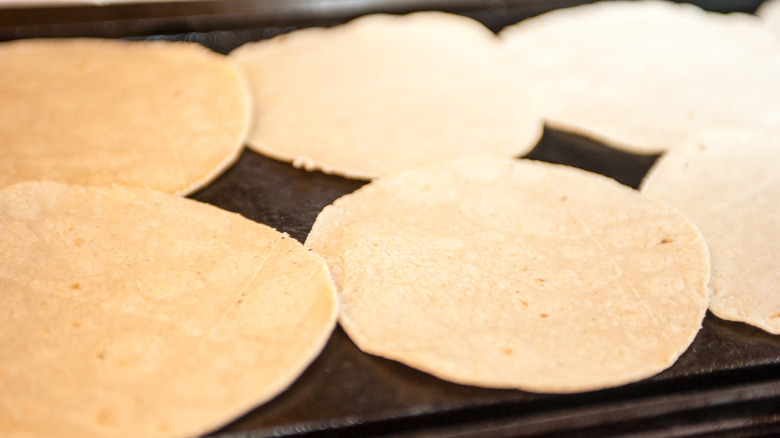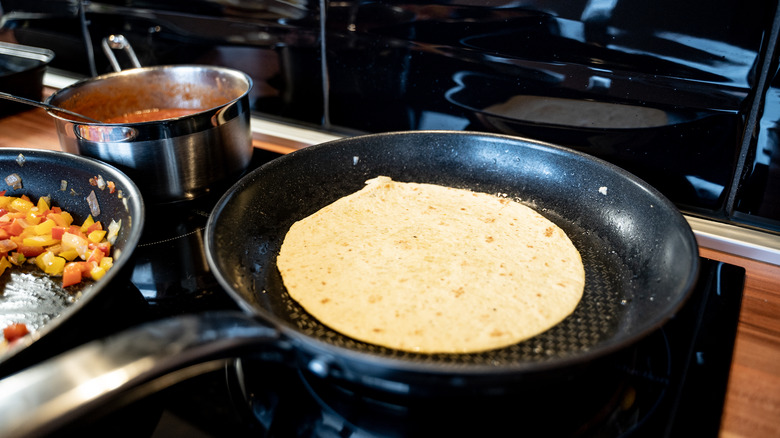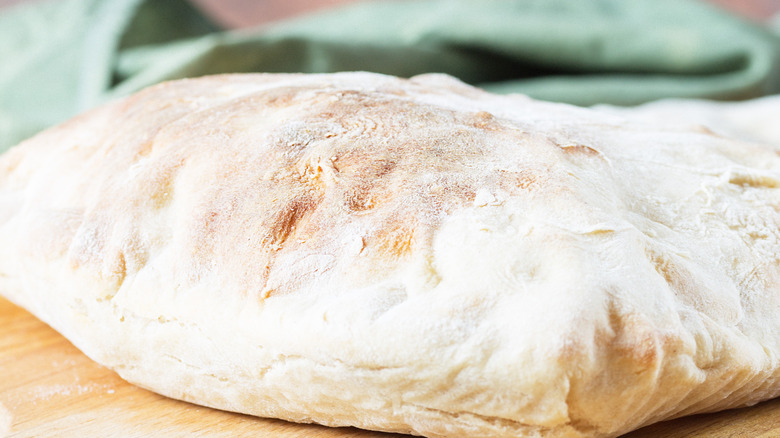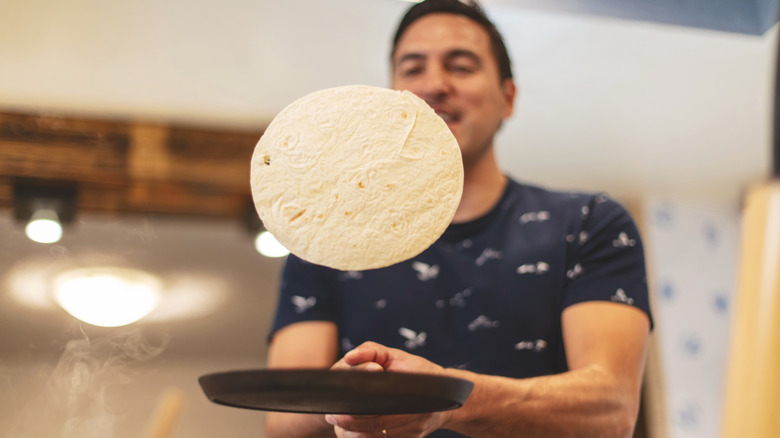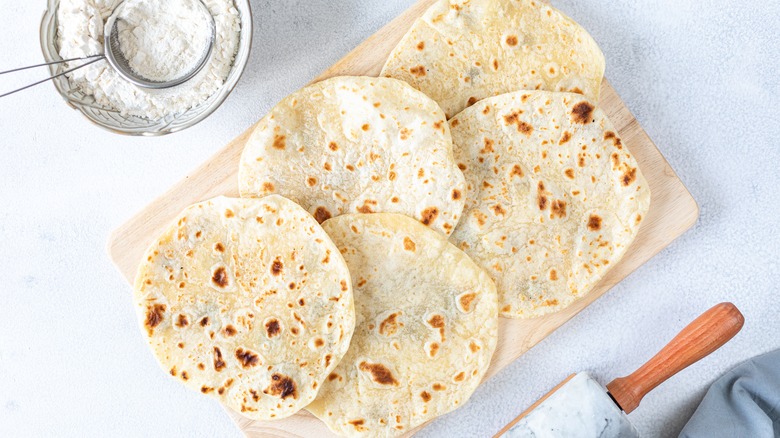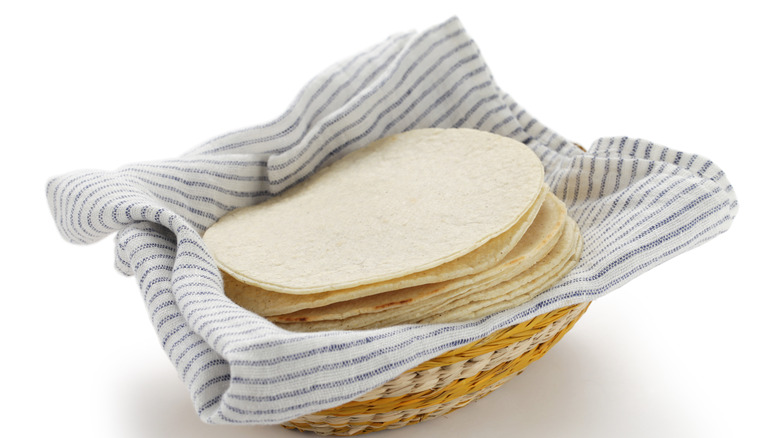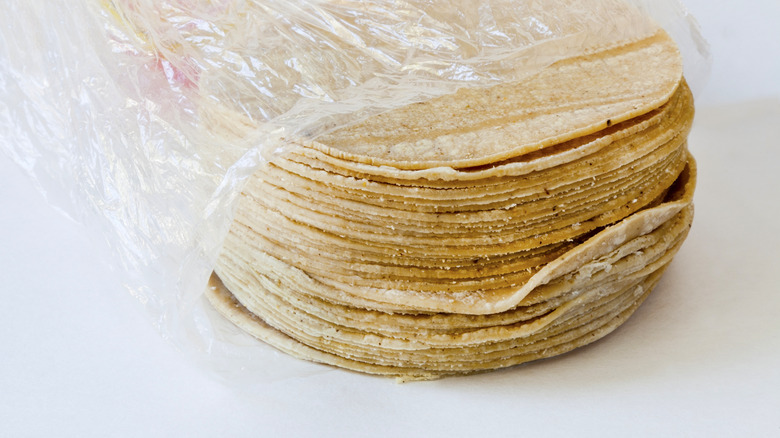14 Tips For Making Homemade Tortillas
You can't have burritos, enchiladas, and tacos without a tortilla. These flatbreads, which are characteristically made of either flour or a corn base, originated in Mayan and Aztec culinary traditions as far back as 12,000 years ago. Not only is this wrap the foundation for some of the most popular dishes in Mexican, Tex-Mex, and Latin American cuisine, but the flatbread can also be used to make sandwich wraps, breakfast wraps, or be transformed into tortilla chips.
If you've ever tried making tortillas at home, you can empathize with the tricky nature of this flatbread. Although it seems deceptively easy to mix the dough, flatten it, and pop it in a skillet, the reality is that making tortillas is nothing but a series of tricky bends after another. Even a single slight miscalculation can lead to a tortilla that's rubbery, dense, and resistant to folding around your fillings. We've collected some of the best advice for making soft, tasty tortillas at home.
Start with the right type of flour
Making a great batch of tortillas at home starts with the right ingredients. You'll need to decide if you're making flour or corn tortillas. The former is typically made with all-purpose flour — which has a gluten content of around 11% to 12%. This gluten concentration is vital because it allows the tortillas to be supple and stretchy without crossing over into being too elastic and bread-like. Although you could substitute bread flour for all-purpose flour, it may be one of the reasons your homemade tortillas aren't soft.
Corn tortillas aren't made with wheat flour, as you could probably tell by the name. Instead, these flatbreads are made with masa harina, which is also called corn dough or masa flour. To make masa harina, flint corn kernels are soaked in calcium hydroxide (slaked lime) through a process called nixtamalization. Then, the dough is ground into a texture that is finer than cornmeal and dehydrated. When remixed with water, this masa flour becomes easily pliable and has the perfect consistency for tortillas. If you're making corn tortillas, we recommend purchasing a reputable brand of masa harina, like Maseca. You can also experiment with making blue, yellow, or even pink corn tortillas using different masa varieties.
Use a solid fat
Some recipes recommend using liquid fat, like vegetable or olive oil, for making flour tortillas. However, the best fat to use in homemade tortillas is more saturated and stays solid at room temperature. Lard is preferable to other types of fat because it does not contain water, unlike butter, which will alter the hydration ratio of the dough. This added moisture can make your dough wetter, thus changing its texture as it cooks. A liquid fat will have the same effect and disrupt the dough's consistency.
Besides producing a superior tortilla, using pork lard will also add more flavor to your tortillas. If you adhere to a vegetarian diet or don't have access to lard, you can substitute hydrogenated vegetable oils, like shortening, in your recipe. Vegetable shortening does not contain any water, so it won't alter your dough's hydration ratio or texture. And if you're trying to steer clear of fat altogether, make corn tortillas instead.
Perfect your hydration ratio
Water is a crucial ingredient in tortilla making — for both flour and corn varieties. An improper hydration ratio will either make the dough too dense or cause it to crack. If you're working with masa flour, the ideal hydration ratio is around ⅔ cup of water to 1 cup of masa harina or 1.3 cups of water to 2 cups of masa for the standard recipe for 18 to 20 tortillas.
But adding the water isn't the only step you have to take to ensure your dough is perfect. The key masa technique for fluffier homemade tortillas is to adjust the ratio depending on the ambient environment of your kitchen. In a humid environment, you may find that the ratio is perfect, but if you're working in a drier climate, you may need to bump up the ratio to between 1½ cups and 2 cups of water per 2 cups of masa. For this reason, it's essential to add water incrementally and go by the feel of the masa rather than the recipe.
Spice things up with herbs
Although the classic version of the tortilla doesn't contain any additional seasoning besides salt, you have some creative license to make your tortillas unique. You can get creative with your homemade tortillas and incorporate some fresh herbs to better pair them with your fillings. Cilantro, basil, parsley, and oregano are some green herbs that offer a mildly herbaceous flavor that pairs well across different cuisines. If you're sticking to Southwestern foods like tacos and burritos, we recommend sticking with cilantro. But if you're adding some mozzarella cheese, balsamic vinegar, and fresh herbs, we recommend adding the other three.
Ground spices like cumin and cinnamon (hello, dessert tortillas!) can also elevate the flavor of your dish. Once you feel comfortable with adding dried or fresh herbs, you can move on to experimenting with other aromatics like chopped garlic and even edible flowers. Another idea would be to use the cooking fat from chorizo or bacon to add to your tortillas. The possibilities are endless when you're the one with the tortilla press.
Avoid overworking the dough
One of the biggest mistakes people make when making flour tortillas (or any kind of bread, for that matter) is overworking the gluten. Some degree of gluten formation is important because it allows the dough to be pliable and easy to work with. But, too much gluten can make your tortillas brittle and difficult to handle. Since masa harina doesn't contain gluten, it can't necessarily get overworked in the same way and does not require a resting period to allow the gluten to slack.
If you're making flour tortillas, the key is to mix the dry ingredients (flour and salt) together with the fat until the consistency resembles coarse sand. Then, once you add the warm water, the texture should be very tacky and stick to your hands easily. Only mix the dough until it is fully incorporated and no spots of dry ingredients remain. Then, you can let the dough rest, hydrating the flour fully and reducing the dough's tackiness.
Invest in a tortilla press
If you're like us, the thought of adding yet another kitchen tool into your space that you may only use once or twice a year is nauseating. But, if you're making corn tortillas, you're going to want to invest in a tortilla press rather than rolling the dough out with a pin or with your hands. The press, which is often made of metal, can easily squish the tortilla balls into perfectly round, thin discs. If you're working with a rolling pin, getting the perfect shape and consistent thickness throughout your batch is nearly impossible. When working with your tortilla press, it's also very important to always add a layer of plastic wrap to prevent the tacky dough from sticking.
Tortilla presses can be used for making more than just tortillas, too. The tool can help you make naan, thin-crust pizza, and scallion pancakes, as well as crush garlic and potatoes.
Flour tortillas tend not to like the tortilla press because the mechanical action can cause the gluten in the dough to strain, thus causing the tortilla to get bready and difficult to work with. For flour tortillas, you're better off using a rolling pin to flatten the dough until it's almost translucent.
Let the dough rest before you press it
Resting is critical for making flour tortillas because it allows the water and the flour to meld together, hydrating the starches and creating the perfect dough consistency. If you're short on time and can't rest your dough, we recommend sticking to a corn tortilla recipe instead since the masa won't require it.
The ideal resting time for flour tortillas is longer than you'd think — around two to three hours. However, you can also make your dough ahead of time and allow it to sit in the fridge for up to three days before pressing it. It's important to keep the dough balls covered in a container or with plastic wrap to prevent them from forming a skin. This skin is the result of the water evaporating from the surface of the dough, which can cause issues with its texture later on in the process.
Make a test tortilla first
Tortillas are notoriously finicky, so it's important to know if you're on the right track with making your dough before you press out a whole batch. Start by taking a golf-ball-sized piece of dough (perfect for tacos), rolling it into a ball, and placing it on your tortilla press. The ideal thickness of your tortilla is almost translucent; this will allow your fillings to shine through rather than rendering your tortilla too bready.
When looking for the perfect tortilla, examine its consistency before flopping it on the skillet. Dough that has cracked edges and a brittle texture will come out of the pan brittle and snap around your filling. This means that your dough wasn't adequately hydrated. Flour dough slicing back into a ball rather than pressing or rolling out easily indicates that the gluten has developed too much and may need more time to rest before cooking.
Always preheat your pan
We can't underscore the importance of preheating in the kitchen enough. Whether you're baking a cake, searing a steak, or in this case, making tortillas, preheating your pan will ensure that your food cooks correctly and in line with the recipe's directions. There are many surfaces you can cook tortillas on. A cast iron pan is ideal because it retains heat better than a non-stick pan. You won't need to add any additional oil to the pan before you start cooking.
Preheating your pan is crucial for homemade tortillas because it will cause the tortilla to puff up and cook relatively quickly. You should allow your skillet to warm up to medium heat for at least five minutes before considering dropping a tortilla on it. Most tortillas require about 30 seconds on each side, but you should be wary of the characteristic puff and any brown spots emerging so you'll know when to take your tortilla off the heat.
Watch for a puff
The ideal characteristic of a perfectly cooked flour tortilla is a puff. The formula for getting this satisfying rise in your dough, which is caused by steam trying to escape, is a dough with the proper hydration ratio, amount of fat, and heat. If the pan is too hot, the dough will stick together and won't puff up. Too cold, and the temperature won't be enough to generate any steam.
If you think you have all of the factors and ratios right and your dough still isn't puffing up, try pressing down on it with your hand or a spatula. Try flipping the flour tortilla, letting it cook for a few seconds, and gently touching the top. Ideally, this mechanical action will cause the dough to spring upwards.
If you want a fluffier tortilla, you can also enlist the help of fresh baking powder. It's important to use baking powder, not soda, for tortillas because the former only requires water to activate. If you have baking soda but no acid, it won't produce any carbon dioxide and help the dough rise.
Avoid overcooking your tortillas
Tortillas are not a food you can step away from while they're cooking. Since most tortillas are finished cooking on each side in under 30 seconds, you'll want to stick around to flip and move them. Otherwise, you risk burning the flatbread and watching all of your hard work go to waste.
If your tortilla has dark, burnt spots or comes out of the pan brittle rather than flexible, it may be a sign that you overcooked your tortillas. Try being more mindful about the next tortillas in your batch to prevent making the same mistake twice. As for your already-made flatbreads, you can wrap them in a warm, moist (but not dripping wet) paper towel to help introduce some moisture back into the bread. Then, microwave the tortilla for about ten seconds so the moisture in the towel can turn to steam. This will make your tortillas pliable but not soaking wet.
Use parchment paper to keep your tortillas warm
If you're working with a small pan, cooking the entire batch of flatbreads and keeping them warm once you pull them off the heat can be tricky. Instead, try this parchment paper trick to get your tortillas ready to eat; it also works great for heating up tortillas in bulk.
Start by separating your tortillas (if they aren't already separated) and stacking them in a tower. From there, you can wrap the stack in parchment paper and microwave the stack for 30 to 40 seconds or until warmed through. Then, wrap the parchment paper stack in aluminum foil to seal in the moisture and heat before placing the tortillas into a gallon-sized freezer bag. If you place the tortillas into a cooler bag, you can expect your tortillas to stay warm and supple several hours after you warmed them — which is perfect for taco parties or times when you don't have access to a microwave to heat them up individually.
Warm your tortillas up before eating them
If you're rushing to assemble your wrap before you leave for work in the morning, you might not think about reheating your homemade tortilla in the microwave. However, you should always warm your tortillas before assembling them because the heat will help them stay soft and easy to fold. It's why most Mexican and Tex-Mex restaurants will serve the tortillas for fajitas in a warmer rather than just on the plate.
There are numerous ways to warm up your fajitas, the easiest being a microwave. Wrap the individual flatbreads in a damp paper towel and microwave for about thirty seconds. If you're working with several tortillas, you can also turn to your oven. Wrap no more than five wraps in aluminum foil and heat them at 350 degrees F for 15 to 20 minutes while you're getting the rest of your fixings ready. You can also use a skillet on the stovetop, heating each for about thirty seconds. Another unconventional tool to use is a slow cooker. Wrap a few tortillas in a damp cloth and place them in the slow cooker. You can remove the tortillas as you need them, which is a perfect reheating method for parties.
Store your tortillas in the fridge
Tortillas are a great meal-prep food because they tend to stay fresh for several days after you cook them. It's not a bad idea to refrigerate tortillas because it can extend the shelf life of both corn and flour varieties. Since these flatbreads have some moisture to them, leaving them out on the counter can make them a prime target for mold and oxidation. Your refrigerator will keep these threats at bay and keep your flour tortillas edible for up to two weeks after cooking them. It's important to note that corn tortillas have a comparatively shorter shelf life of up to three days after cooking, but refrigeration may extend it a few more days.
To properly store your flatbreads, completely cool them before wrapping them in an air-tight storage bag or container. If you put the tortillas in the bag warm, the steam will cause them to stick together and make for a tortilla stack rather than individual wraps.
